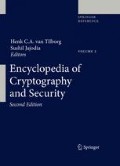Access this chapter
Tax calculation will be finalised at checkout
Purchases are for personal use only
Recommended Reading
Courtois N, Finiasz M, Sendrier N (2001) How to achieve a McEliece-based digital signature scheme. In: Boyd C (ed) Advances in cryptology – ASIACRYPT 2001. Lecture notes in computer science, vol 2248. Springer, Berlin, pp 157–174
Wagner D (2002) A generalized birthday problem. In: Yung M (ed) Advances in cryptology – CRYPTO’02. Lecture notes in computer science, vol 2442. Springer, Berlin, pp 288–303
Coron JS, Joux A (2004) Cryptanalysis of a provably secure cryptographic hash function. Cryptology ePrint Archive. http://eprint.iacr.org/2004/013/
Finiasz M, Sendrier N (2009) Security bounds for the design of code-based cryptosystems. In: Matsui M (ed) Advances in cryptology – ASIACRYPT 2009. Lecture notes in computer science, vol 5912. Springer, Berlin, pp 88–105
Author information
Authors and Affiliations
Editor information
Editors and Affiliations
Rights and permissions
Copyright information
© 2011 Springer Science+Business Media, LLC
About this entry
Cite this entry
Finiasz, M., Sendrier, N. (2011). Digital Signature Scheme Based on McEliece. In: van Tilborg, H.C.A., Jajodia, S. (eds) Encyclopedia of Cryptography and Security. Springer, Boston, MA. https://doi.org/10.1007/978-1-4419-5906-5_380
Download citation
DOI: https://doi.org/10.1007/978-1-4419-5906-5_380
Publisher Name: Springer, Boston, MA
Print ISBN: 978-1-4419-5905-8
Online ISBN: 978-1-4419-5906-5
eBook Packages: Computer ScienceReference Module Computer Science and Engineering

